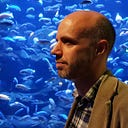‘The Image Book’ or — The Five Finger Shuffle?
There’s a moment at the start of ‘The Image Book’ (2018) where Jean-Luc Godard refers to the fingers of his hand as “fairies” as we watch a film reel delicately manipulated through an editing machine. This signifies Godard’s approach to his latter day filmmaking as an activity of letting his hands do the thinking rather than the mind, or even the eye. The results are retina-meltingly phenomenal and brain-bafflingly immense.
So the title of ‘The Image Book’ automatically raises a few questions — does this film consist of images, texts, images and texts, images vs. texts and how do we (mis)read them? (Hey, Godard goes nuts with his parentheses here so let’s join in the fun too!)
‘The Image Book’ is an essay film where Godard pulls in footage from the entire history of cinema — von Sternberg, Ophüls, Godard himself (!!!) — along with a vast variety of video, cell-phone and TV broadcasts etc. And the sensation of physical tactility is immediately strong here, that this is cinema as clay, as Godard blows out the colour contrast to the extreme producing some ravishing, hypnotic and truly idiosyncratic images; it feels like a reinvention of light. Familiar images and visual clichés — clouds, waves, nuclear explosions — undergo a sort of luminous resurrection (look, this IS a Godard film we’re talking about here so let’s not be coy) forcing new meaning to be considered (Rivette and Rohmer briefly pop up but are digitally “dissolved” to be almost unrecognisable).
This is combined with Godard’s typically sophisticated use of music and sound where everything is a hard cut, a razor-edged sonic slice (you’ve more chance of finding slapstick comedy in a Tarkovsky flick than a smooth audio fade in Godard) that destroys musicality in music and provides musicality to noise, turning the viewer into an “acoustic spectator”. It also helps he gets to raid Manfred Eicher’s ECM music library, the lucky fucker. Musical and visual patterns share certain phrases, intervals and rhythmic energy (notice there are “waves” and there are “waves”) allowing us to create new relations and experience the ecstatic jolts of our habits being smashed.
This comes to a (very funny) climax near the end when the narration (spoilers!), already tumbling over itself, becomes so convoluted, so garbled, it feels as though ‘The Image Book’s voice-over is choking on itself to death. To ram the point home Godard pulls in the clip from Ophuls ‘Le Plaisir’ (1952) of the old man disguised as a youth dancing himself to the edge of death, an attempt to mask aging and mortality through an image. It is surprisingly humourous, moving and profound.
Yet the main bulk of ‘The Image Book’ grapples with the underrepresentation of the Arab world in cinema and the pervasiveness of Orientalism in film. How do you strip out Imperialism in film? After all, American cinema was effected by 9/11 because it was the most effective, free pre-vis footage for urban destruction any director could’ve wished for (“Oh, so THAT’S what it would look like if two major New York buildings collapsed! Thanks terrorists for the footage!”) but do we ever ask what the effect was of it all was on Middle Eastern film and images? Godard, wisely, stays away from easy shock imagery, but it’s constantly there (sometimes masked), implicit in the background informing and commentating much like the sound does. It doesn’t provide answers and doesn’t really raise questions but it gives us a new way of looking, of ripping off the beautiful mask of Ambroise to see a “truth” beneath.
Yet if I utter (maybe “whisper” is more accurate) the word “truth” then I must be honest with myself because for all the cerebral, political and social speculating and pontificating I’ve engaged in above the biggest kick I got from ‘The Image Book’ was from simply gorging myself on its visuals and sound. This is an almost impossibly beautiful film where archive footage, montage and blisteringly impossible colours scream out the screen at you, almost as though Bill Morrison and Stan Brakhage had had a baby made out of a particularly aggressive rainbow.
‘The Image Book’ is fantastic and might be the most energetic, radical and dynamic movie ever made by an 88 year old man. I’m still grappling to figure out what it all meant (it could, much like this piece I’ve written, all be a load of wank!) but I’m in no doubt I absolutely loved what I experienced.
